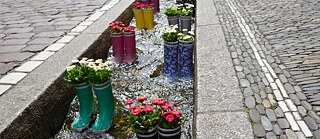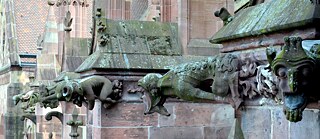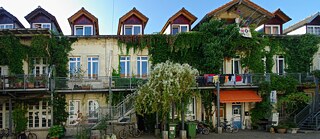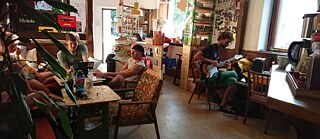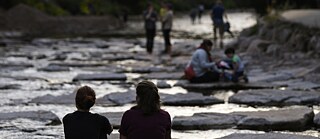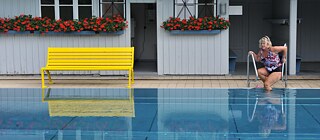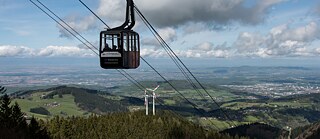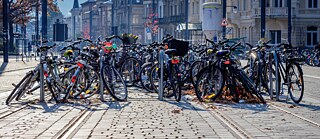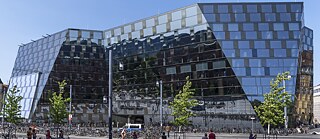Freiburg is known throughout Germany as a green city. Our author Gina Kutkat explores the sunny town in the Breisgau Region to see what this means. Along the way she uncovers spots with a unique flair and open-minded inhabitants, while underscoring contours not visible at a first glance.
By Gina Kutkat
Saints and sinners at the tofu stand
Gargoyles at Freiburg Minster.
| Photo (detail): © Adobe
Climb to great heights or take a quick walk-round: Built between 1200 and 1530, the Freiburg Minster is the city’s landmark. Ambitious climbers can brave the 265 steps of the 116-meter-high spire for a spectacular look at the city from the viewing platform. For those who prefer their history with both feet planted firmly on the ground, the minster’s high altar is sure to please. It is adorned with countless figures including saints, gargoyles, fools and grotesque, demonic faces, all symbolically meant to deter and denounce both vice and mortal sin. Newcomers to the city can use the spire as a helpful reference point. Locals also value their cathedral the adjacent marketplace, where daily life takes place. In addition to regional and seasonal products, there is a lot to discover among the colourful market stalls and tofu food trucks. Like the cheesecake Stefan Linder began baking according to a secret recipe 17 years ago. He sold the first confections at the Münster Market, where you can still taste the creamy cake today. Meanwhile this local favourite has expanded its followers well beyond the city limits of Freiburg and is sold at various markets and delicatessens.
A slight left turn
Radio Dreyeckland is also at home in the Grether Compound.
| Photo (detail): © Joergens.mi/Wikipedia CC-BY-SA-3.0
With rising rents, vacant buildings and gentrification, Freiburg’s housing market has gone a bit off the rails. There are landlords who fib about needing their property for their own use just to drive out sitting tenants. And there are activists taking a stand against the horrendous rents and displacement. This is reminiscent of Freiburg’s squatter past, which resulted in the Grethergelände or Grether Compound. Activists successfully blocked the slated demolition of the Grether & Cie company factory buildings in the 1980s. Today, the Mietshäuser Syndikat (Apartment-House Syndicate) offers affordable living space for around 100 people on the site close to the city centre. Grether is also a self-governed home for many left-wing projects: The feminist women’s centre, Rosa Hilfe, Radio Dreyeckland and the Freiburg Forum aktiv gegen Ausgrenzung (Freiburg Forum against Active Exclusion) have their offices here. People meet up at the Strandcafé, an open, non-commercial space for exchange and encounters, or at the legendary courtyard festivals in the summer.
Get married or just dip your toes
Wellingtons as planters in a Bächle.
| Photo (detail): © Adobe
There is an old, romantic saying that claims, “If you step into the Freiburg Bächle , you will marry a native of Freiburg”. There are no statistics on how often this has actually happened, though there are sure to be plenty who have taken that step. Around 9.5 kilometres of Bächle (small streams or brooks, “le” is the diminutive used in Baden) has meandered through Freiburg’s streets and alleyways since the Middle Ages. In the past they were used to water livestock and extinguish fires, but today they fulfil a different set of needs: In summer, their chilly waters are an ideal place to cool tired feet or an after-work beer. A tiny brook boat available at the cathedral market will make a child’s day as they sail it up and down the little runnels. A Freiburg non-profit has been building the beloved wooden boats with colourful mini sails since 2009. The Bächle have featured a few prominent waders too, by the way, such as former German Chancellor Gerhard Schröder who dipped his toes during a visit by Jacques Chirac in June 2001.
For night owls and culture lovers
“Bis Späti” is Freiburg’s only late-night shop.
| Photo (detail): © Bis Späti
Freiburg’s nightlife does not have the best reputation, and many clubs and bars have been forced to close in recent years. There are still a few options for a fun evening out in the Stühlinger district, lovingly known to locals as the “Stühli”. The only late-night shop in Freiburg opened its doors here in summer 2019. The kiosk provides services after the usual stores have closed for the night. A collective of eight young people take turns selling everything the heart desires and organizing concerts and small events as well, such as an open lunch in return for donations. The Stühli is a good place for a cold brew in the Beat Bar Butzelmann on Eschholzstraße or the Bar am Funkeneck. The Artik in Haslacher Straße organises the popular freestyle rap open mic nights Rap Anker and the Slow Club gives music lovers of other genres, like postpunk, electro, psychedelic and doom rock, their money’s worth. For this important public service, the club calls itself an association of needed cultural input. For a little extra culture: The Theater der Immoralisten (Theatre of the Immoralists) puts on modern theatre, so be sure to check it out.
A pool at its heart
People along the Dreisam River
| Photo (detail): © picture alliance/Patrick Seeger/dpa
If you want to discover what makes the residents of Freiburg tick, the best place to go is where they like to be most: along the Dreisam. The river flows through the whole city and there are many ways to enjoy its cool waters. This is where everyone congregates as soon as the sun reappears for the first time around the middle of February. Some jog, cycle or walk, others hang up their hammocks or slacklines, splash around in the water, and chill. Between the Greifenegg Bridge and the Dreisam Swing at Mariensteg, the fish ladder is an inviting spot for a swim. The giant ramp was designed to help fish swim back up the Dreisam, but is also a popular pool at the heart of the city. Further east, between Sandfangweg and the youth hostel, the Dreisam is ideal for wading. Relax on the Sandfangwiese (a grassy field) or along the miles of Dreisam riverbank.
No cars allowed
Low energy buildings in the Vauban district
| Photo (detail): © picture alliance/Daniel Schoenen/imageBROKER
Freiburg is known for being green. It was one of the first cities in Germany to have a green lord mayor, cyclists are kings and queens of the streets, and Weingarten-West features Germany’s first passive high-rise building - a particularly well-insulated building that drastically reduces heating costs. The city even has an area where cars are no longer welcome. Hop aboard a tram and ride into the showcase Vauban district built on the site of a former French military base. In 1993, students and squatters set out to create an environmentally conscious and family-friendly neighbourhood here. Today the inhabitants get their hot water from geothermal energy and feed their organic waste into a biogas plant. Stroll through the Vauban and discover chicken coops and composting machines, but no cars – they have to stay in the four car parks on the edge of the quarter.
Women swimming
Women swimming: the Lorettobad.
| Photo (detail): © picture-alliance/Rolf Haid/dpa
What used to be the norm is now unique to Freiburg: a swimming pool with separate pool just for women. People have been splashing around in the Lorettobad – or Lollo for short – since 1841. At first it was a gentlemen-only pool, but a separate ladies’ pool was added in 1886. This was not unusual in the German Empire where segregation by sex was quite common in swimming pools. What makes the Lollo unique is that this area is still reserved exclusively for women and small children. Most fall in love with the nostalgic bath during their first visit and return again and again. Men too, by the way, who are welcome the adjacent family outdoor pool. There are long waiting lists to lease one of the charming cubicles. The classical concerts organised by the Freunde des Lorettobads e.V. are also popular.
One home mountain for all
View from the Schauinsland cable car.
| Photo (detail): © picture alliance/Patrick Seeger/dpa
Schauinsland: The name of Freiburg’s home mountain, which literally translates as “look into the countryside”, says it all. Enjoy the most beautiful panoramic view of the city from 1284 metres above sea level. Even the 40-minute journey from the city centre is charming: travel by tram and bus to Günterstal - where you can make a pit stop at the young Günters Coffee Roasters company - to the Schauinsland cable car mountain station, then float in a gondola to the top in 20 minutes. This mountain is where generations of Freiburg residents have sledged for the first time or learned to ski. Whether you enjoy walking, biking, tobogganing, winter hiking or just dropping by for a bite to eat, a day on the Schauinsland is as essential to Freiburg as the marketplace is to the cathedral.
Me and my bike
Bikes as far as the eye can see
| Photo (detail): © Adobe
Freiburg is a Mecca for cyclists. They rule the streets and are outdoors in all weathers, always true to the motto “there is no bad weather, just the wrong clothing”. Fortunately, Freiburg is considered the Tuscany of Germany, the region with probably the most hours of sunshine. The more than 400 kilometres of cycle paths also contribute to the fact that the bicycle is the city’s most popular means of transport. More than a third of all the kilometres spent on the roads are on a bike and 14,000 cyclists a day sprint past the bicycle counter at the Blue Bridge. And there are more to come - at least that is the aim of Freiburg’s Bicycle Traffic Concept, which aims to further increase the proportion of cyclists and significantly reduce the number of bicycle accidents. Even coffee is also served by bike in Freiburg: In good weather, the cargo bike barista travels to the square of the Old Synagogue every day – from the Vauban, obviously.
Beloved Death Star
The university library is also fondly known as the “Death Star”.
| Photo (detail): © picture alliance/Helmut Meyer zur Capellen/imageBROKER
The approximately 25,000 students of the Albert Ludwigs University shape the cityscape of Freiburg. Since 2015, they have done their revising in a futuristic building: the university library, also known as the Death Star, designed by Basel architect Heinrich Degelo. Some love it, others just laugh because it has been plagued by one problem after another since it opened. It cost 53 million euros to build and the hits just keep coming: not enough space, a leaky façade, a black glare shield had to be added to keep drivers from being blinded by the sunlight reflecting off the glass and chrome steel walls. Fortunately, nobody was hurt when parts fell out of the façade in August 2018. Despite all the mishaps, the library remains a real architectural eye-catcher where thousands of students flock to get their work done.
City Contours
Allotments in Berlin or skinny-dipping in Munich: come and explore some German cities with us – also against the grain. We give you an outline of the classic places, communities and events that are an intrinsic part of the city profile – and we redraw the contours by challenging a few clichés.
